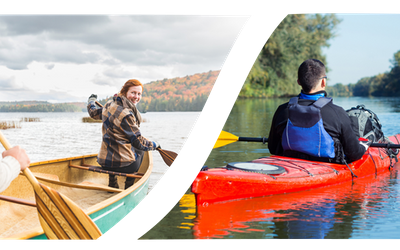The Difference Between Canoeing & Kayaking
Is there a difference between canoeing and kayaking? And if you were handed a canoe paddle and a kayak paddle is it a case of choosing either / oar?
Canoeing and kayaking are quite separate pursuits. The main differences are the paddle used and the position of the canoeist or kayaker in the boat.
Canoeists use a paddle with a blade at just one end while paddling a kayak involves using double-ended paddles. Canoes are open in design while a kayaker is “sealed” into their boat.

Purpose & Design

People often describe a canoe as being like a people carrier and a kayak like a sports car. A canoe is often used for meandering down a river while a kayak is favoured for competitive conditions in challenging water.
It’s not always that straightforward as there are many different designs of canoes and kayaks. Some further confusion comes from the Olympics classifying both types of boats used in the games as a “canoe”. Vessels are classified by letters and numbers to aid identification. A “C” stands for canoe and a “K” for kayak. A C1 canoe is a solo paddler and a C2 a tandem. The same holds true for K1 and K2 kayaks.
Both types of boat can be used for recreational purposes such as water sports, fishing and generally travelling along a stretch of water. You will see canoes on white water but generally, kayaks are better suited to riding rapids and challenging stretches whereas canoes are ideal for calmer rivers and inland lakes.
Seating in a canoe and a kayak

Canoeists sit or kneel in their vessel while kayakers will sit lower in the hull and stretch their legs inside the boat. Canoe paddlers will wedge their knees against the sides of the boat for stability.
Canoes normally have an open deck allowing you to pack your belongings in the boat for a day out while kayaks have an enclosed deck and when used in white water will often be fitted with a spray skirt which surrounds the paddler to keep water out of the vessel.
Paddles used in canoeing and kayaking

Kayakers used a double-bladed paddle because the boat sits low in the waterline meaning a single blade would not provide efficient motion. In their earliest forms, Eskimos developed the Eskimo roll using two blades to right themselves in icy water.
A kayak paddle is longer than that used in a canoe and the blades are mounted at 90 degrees to each other to enable a twisting motion to gain speed.
A canoeist uses a single blade with a “T”-shaped handle at the top. To propel a canoe, the oarsman will alternate plunging the blade in the water to the left and the right of the boat.
Canoeing and kayaking clothing and accessories

When it comes to canoeing and kayaking accessories, because kayaks are often used for running rapids, the paddler will tend to equip themselves with a helmet and noseplug. Canoeists tend to wear a collared lifejacket while kayakers are more likely to wear a buoyancy aid to allow more freedom of movement. You may need to protect your hands as well so there are paddling gloves that come in different weights and are suited to different water and atmospheric conditions.
When it comes to canoeing and kayaking clothing, a day out canoeing probably won’t result in you getting very wet so t-shirts and shorts are fine in the summer, along with something to keep the rain off and perhaps a fleece for chillier days. Layering works well for colder weather.
However, usually, kayakers can expect to get wet so a wetsuit is often required. A rash vest worn underneath the wetsuit will add a little extra comfort, too. Wetsuit shoes or boots may also be required but some well-draining sandals may be enough for warmer days. Rocks, shells and glass can cause injuries so in such conditions so boots with a thick rubber sole are a good idea, as they offer good grip on rocks and riverbanks.
Whatever discipline, type of boat and sort of water you choose to canoe or kayak in, what you wear will depend on the paddling environment and likelihood of taking a swim. The beauty of canoeing and kayaking is that there really is a type of vessel and water conditions to suit everyone.


